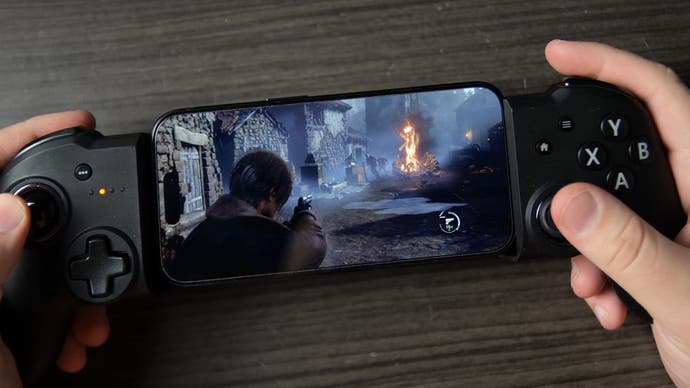Resident Evil 4 on iPhone 15 Pro targets the PS4 experience - but doesn't quite hit the target
Fine for mobile play - but not quite the triple-A experience.
Resident Evil 4 was one of the most accomplished remakes of 2023, a modernised, bold reinterpretation of Capcom's 2005 action-horror classic. It looked great too across current-gen platforms as well as PS4, with great lighting detail and excellent art design. As the year closed out, Capcom delivered RE4's first mobile port. As a part of Apple's recent triple-A gaming push, Resident Evil 4 is now available on iPhone 15 Pro and M1 and M2 based iPads, representing the fastest of Apple's mobile hardware. So is the game hung up on performance and configuration issues like Resident Evil Village? Or is RE4 a capable conversion of the console code?
Resident Evil 4 was for the most part a current-gen console and PC experience, but Capcom also shipped the game on PS4 console systems. The visuals were mostly preserved on Sony's eighth-gen machines, but there were some notable cutbacks. Most notably, texture resolution took a big hit, and texture streaming could be pretty slow. There were a range of lighting cutbacks as well, including a reduction in the number of shadow-casting light sources, and absent screen-space reflections.
Those cutbacks need to be kept in mind, because the PS4 code proves the closest match of all the console versions for the results seen on iPhone. Unlike Resident Evil Village, RE4 doesn't have a PC-style settings menu, so we're effectively getting one basic visual experience on the platform, with some options to adjust lens distortion, depth of field and motion blur, like we saw on all console versions of the game.
The first thing that should stand out here is that the iPhone version has a very obvious blue tint for some reason. It's also much darker than the PS4 version with the default brightness and I'd recommend anyone else playing the game in SDR do the same. Textures look pretty similar for the most part between the two versions. If you look closely though, the iPhone code does feature some noticeably lower-res texture art through a lot of the game's environments. These aren't huge differences, but the world just looks a bit blurrier and less well-defined in general. Curiously, a lot of the same issues with texture loading were seen on PS4, despite the iPhone's much faster storage.
Looking through the environment, there are some reductions in level of detail settings between the PS4 and iOS versions. This is most noticeable on smaller incidental objects and there are also some very obvious reductions in foliage density. Treelines look pretty similar, but patches of grass and bushes are less thick on the iPhone than PS4. A lot of the lighting is pretty similar across the two games. Primarily, this is closely related to how the lighting in RE4 works in general, as it features a lot of baked lighting that translates similarly across the two platforms. Screen-space reflections are also absent, although as those familiar with the RE Engine SSR can attest, this is probably a good thing for the game's visuals overall. On the plus side, volumetrics do return, though resolution has taken a small hit relative to the PS4.
Looking at shadows, the actual resolution in most scenes isn't particularly impressive, though a quick glance at the PS4 code reveals a very similar shadow res on that platform. The primary issue here I think is the dither pattern that's used to give an impression of shadow softness. On the PS4 it looks acceptably fine-grained, but on iPhone it looks very coarse and unconvincing. I think this may be related to the very low internal resolution of the iPhone version - as there are certain aspects the MetalFX AI upscaler has trouble working with.
Post-processing also takes a hit. Looking through some of the more action-packed cutscene sequences, the motion blur looks pretty rough and undersampled at times, though I think again that this may be related to the lower internal resolution on iPhone. Depth of field isn't as obvious, and can exhibit some pretty nasty artifacts around character edges. These effects don't really carry the same cinematic flair that we see on PS4, though I think on the smaller iPhone screen they mostly look okay. In terms of general visual settings, the iPhone code measures up just fine relative to PS4. No, it's not offering the exact same visual experience as we'd see on console, but you are getting similar enough underlying settings that it still looks very much like Resident Evil 4. This is far better than what you'd expect from a Switch port of this game, for instance.
Image quality is probably the biggest sore spot though. The PS4 code, for its part, looks pretty good, with a 900p image combined with TAA for a fairly smooth and detailed final resolve. By last-gen standards, image quality is perfectly reasonable on that platform. The iPhone just doesn't hold up well by comparison. The game tends to have a lot of 'salt-and-pepper' disocclusion artifacts all over the screen at times. Almost any time there's substantial movement in the frame, these issues are noticeable, especially around Leon's hair and in foliage elements.
I think it's all about the resolution. I counted a resolution of roughly 300p across several shots, which I suspect is being upscaled to something in the region of 720p using MetalFX's machine learning based temporal upscaler. Going back to Resident Evil Village on iPhone, there are similar levels of break-up, it's just less obvious in general because of the first-person camera, and because of the general lack of foliage in Village.
To be fair, in still shots the game's image coheres surprisingly well for a game that operates at these kinds of internal resolutions. Interior areas fare best, where minimal alpha effects result in fewer artefacts. Considering the performance savings and the smaller iPhone screen used to navigate the game, I don't really think this is that bad of a solution, though it would have been better to combine MetalFX with higher-resolution rendering to get a truly stable and consistently good-looking final result. Upsampling solutions just don't tend to work well when they have to work with so few pixels.
Clearly, the low internal resolution is about preserving and maintaining performance, where Capcom targets 30 frames per second. Throughout typical combat and exploration, the game does hit the target, but there are some pretty big issues. Firstly, frame-pacing is incorrect, similar to many 30fps iOS games. It's not horrible here - Resident Evil 4 fluctuates between 33ms and 16 ms every so often, with a steady beat of 33 millisecond frames in between. It's annoying, but not a dealbreaker. However, in addition to that, there are some occasional very heavy frame-rate drops that seem to come out of nowhere, where the game becomes a bit of a slideshow for a few seconds. These aren't terribly frequent - occurring maybe once every five or 10 minutes - but they do bring you out of the experience.
I also noticed a couple of lengthy stutters during gameplay along with more conventional performance problems as well, as the game struggles to maintain its 30fps target in some moments. The frame-times aren't wildly out of bounds here, it's just that the game is on the edge of maintaining 30fps and just can't quite get there. Resident Evil 4 isn't a great performer by any means, but it does fare quite a bit better than Resident Evil Village on iPhone. That suffered from prolonged frame-rate dives during typical gameplay, even when running on the lowest settings - something that subsequent patches never addressed.
For reference, the PS4 release ran Resident Evil 4 with an unlocked framerate that ran from 30 to 60fps in typical play. It wasn't ideal, but it does feel smoother than the iPhone code - and its frame-times tend to be more under control than the iPhone. PS4 did use reduced-rate animation on enemy characters when facing large groups of foes, however, a concession that the iPhone doesn't employ. Additionally, loading times are another win for Apple's smartphone. A load that takes roughly 40 seconds on PS4 completes in just seven seconds or so on iPhone, a gain probably attributable to the iPhone's advanced CPU and fast flash storage. On mobile platforms, every second counts, and the iPhone generally fares quite well when loading saves in RE4.
The controls are a bit of a mixed bag. On the plus side, the game supports both Xbox Series and PS5 pads without issue, and there's even a toggle to swap button layouts between the PlayStation, Xbox, and Nintendo styles. Rumble works fine and all the buttons function normally. Input lag is an issue though - I measured about 200ms input lag here when connected to a Bluetooth controller, and the game has a pretty heavy feel in general. It's not unplayable, but it never really feels responsive.
I'd recommend against trying to play this game without a gamepad, because the touch controls are very barebones. The game presents every single button on the screen at all times, which makes it pretty tough to control. The best adapted iPhone games use context-sensitive controls, like the GTA Definitive Editions, with buttons only popping up as needed or serving dual purposes depending on the situation. Simply overlaying a modern gamepad layout across the majority of the screen is not a particularly effective solution.
Summing up, there is progress here. Resident Evil 4 on iPhone is definitely an improvement over Village. Users don't have to fiddle around with complex and crash-inducing visual settings, and the game actually runs acceptably for the most part, with a somewhat unsteady, but reasonably performant 30fps update. This is a better-configured game than Village - and Village's unique performance gremlins don't seem present here - but I think expectations for Apple's triple-A gaming push are a bit higher.
Outside of the three games I've reviewed recently on iPhone - RE Village, the GTA Definitive Editions, and of course RE4 - there's not too much like this game on iOS. Visually speaking, the closest title I've played might be Wreckfest, a last-gen racer that can hit 60fps on iPhone 15 Pro, or Genshin Impact. But excepting those games, the most sophisticated iPhone software is roughly at an Xbox 360/PS3 level of basic visual fidelity or below, so it's hard to judge exactly what we should expect from a title like RE4 that essentially amounts to a PS4 port.
I'm inclined to think that a closer 30fps lock should be at least achievable in these kinds of games, while maintaining decent image quality and settings. Upcoming Apple Silicon titles - most notably Death Stranding and Assassin's Creed Mirage - will put this to the test, and I hope we will see a truly polished last-gen iOS port in 2024. But so far, the results have been more mixed, with better results on the visual front than in performance. Resident Evil 4 is at least good enough that I think it makes for a reasonable mobile experience, as long as you keep hopes in check. You'll have to tolerate substantial performance issues and a sometimes messy image, but this is still Resident Evil 4 on the go, and it looks decent and doesn't crash. It just lacks the performance and visual consistency that a lot of players expect.




















